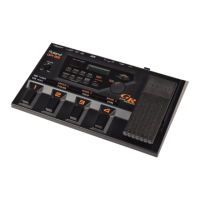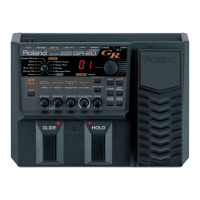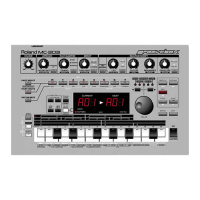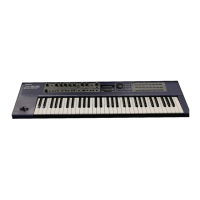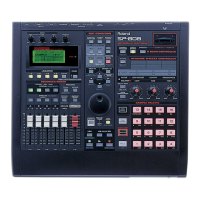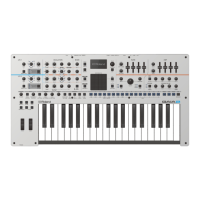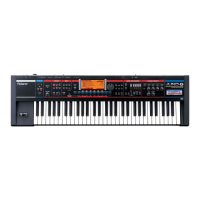Let’s choose some of the preset patches (E11 through
H84) to hear some actual examples of Arpeggiator’s
effects.
First, in the Play mode, set the PARAMETER SELECT
dial to “PATCH INC/DEC BY S1/S2,” use “S1” and
“S2” on the GK-2A to choose a patch, and use pedal 4
to switch Arpeggiator on and off.
✽
When Arpeggiator is on, “ARP/HAR” in the five-point
indicator lights up green. (The red light indicates a
patch selected by Harmonist, and not Arpeggiator. -> p.
64).
Reproducing Arpeggios from
Guitars and Other Instruments
Patch E21 reproduces an ensemble composed of a six-
string guitar and a 12-string guitar.
When a chord such as Bm or F# is fingered and all
notes are strummed, Arpeggiator is activated and the
notes of the 12-string guitar (on the right-hand side)
are played with arpeggios. Use pedal 4 to switch
Arpeggiator on and off and hear how the perfor-
mance differs when Arpeggiator’s effect is added and
taken away.
Techno (Dance) Arpeggios
Playing a single note or chord for patch H83 plays a
synth bass sound.
The rhythm automatically applied with this patch is
also generated by Arpeggiator. Try switching
Arpeggiator on and off with pedal 4.
With E31, plucking an open string plays a trance-tech-
no phrase loop that combines bass and percussion
sounds. You can change the pattern by varying the
number of strings plucked and the position fingered
with the left hand.
By using the expression pedals to change tempo and
pitch (p. 49) and synchronizing the MIDI tempo to an
external automatic performance system (p. 56), a
patch like this that offers dance (techno) patterns can
be used to develop impressive performances with
unbelievable guitar sounds.
Reproducing Tremolo Effects
Patch H32 plays marimba tones.
Arpeggiator is turned off when this patch is called up,
but using pedal 4 to turn it on results in marimba
sounds with tremolo. In the same way, E11 repro-
duces a nylon-string guitar with tremolo.
Other Ways to Use Arpeggiator
Patch E14 plays percussion as backing for a sitar-type
string-instrument sounds.
Arpeggiator automatically adds percussion (second
tone) according to the string that is played, producing
an ethnic ambience.
Also, H84 adds a delay produced by the built-in
reverb to the arpeggio, and playing the appropriate
chord one full stroke reproduces an Eighties-style gui-
tar and bass ensemble.
All other preset patches include other patterns of
some type, including those for which arpeggios are
off and those Harmonist is selected.
Try switching Arpeggiator on and off with pedal 4
while using “PATCH INC/DEC BY S1/S2” to change
patches, and listen to the different patterns. (To listen
to the patterns of patches for which Harmonist is
selected, follow the steps on p. 55 to switch the setting
for “ARPEGGIO/harmony SEL” to “ARP” or the like.
52
Arpeggiator Application Examples

